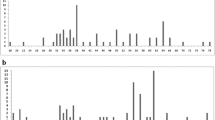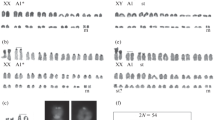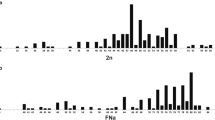Abstract
A total of 219 wild caught specimens representing 12 of the currently recognised 13 species and subspecies of Australian Rattus have been karyotyped. No two species possessed karyotypes in common, most species and several subspecies differing markedly in chromosome number. While the diploid number varied from 2n=32 to 2n=50, the fundamental number (FN) varied only from 60 to 62, suggesting that Robertsonian rearrangements have played a major role in karyotypic evolution in the group. — Karyotypically the Australian species of Rattus fall into two groups. — the R. lutreolus group and the R. sordidus group. Of the karyotypic forms encountered in the former group, that of R. lutreolus is probably most ancestral because it is identical to that of many Asian species of Rattus. Other karyotypic forms in the R. lutreolus group can be derived as follows: That of (1) R. tunneyi tunneyi and R. t. culmorum by a single fixed pericentric inversion; (2) R. fuscipes fuscipes, R. f. greyi, R. f. assimilis and R. f. coracius by two fixed fusions; (3) R. leucopus cooktownensis by three fixed fusions; and (4) R. leucopus leucopus by four fixed fusions. Of the R. sordidus group, R. s. villosissimus may possess the most ancestral karyotype with 2n=50 (FN=60), from which R. s. colletti (2n=42; FN=60) is derived by four fusions and R. s. sordidus (2n=32; FN=60) by nine fusions, four of which appear to be homologous with those R. s. colletti. — The karyotypic data are in accord with Taylor and Horner's (1973) suggestions that (1) R. t. tunneyi and R. t. culmorum belong to one species; (2) R. lut. lutreolus and R. lut. velutinus belong to one species; (3) R. leu. leucopus and R. leu. cooktownensis belong to one species and (4) R. f. fuscipes, R. f. greyi, R. f. assimilis and R. f. coracius belong to one species. However, the large karyotypic difference between R. s. sordidus and R. s. colletti and R. s. villosissimus may indicate that these groups belong to different biological species. — Supernumerary or B-chromosomes were found in R. f. assimilis and R. t. tunneyi. A single R. t. culmorum was heterozygous for a centric fusion.
Similar content being viewed by others
References
Amrudz, J.: Centric fusion of chromosomes in Norwegian red cattle (NRF). Hereditas (Lund) 62, 293–302 (1969)
Arrighi, F.E., Hsu, T.C.: Localization of heterochromatin in human chromosomes. Cytogenetics 10, 81–86 (1971)
Baverstock, P.R., Watts, C.H.S., Hogarth, J.T.: Karyotypic data and the specific status and taxonomic affinities of Rattus villosissimus and R. sordidus. Aust. J. Zool. 23, 293–294 (1975)
Baverstock, P.R., Watts, C.H.S., Hogarth, J.T.: Heterochromatin variation in the Australian rodent Uromys caudimaculatus. Chromosoma (Berl.) 57, 397–403 (1976)
Baverstock, P.R., Watts, C.H.S., Hogarth, J.T.: Chromosome studies of Australian rodents. I. The Pseudomyinae, Hydromyinae, and Uromys/Melomys. Chromosoma (Berl.) 61, 95–125 (1977)
Buckton, K.E., Cunningham, C.: Variations in the chromosome number in the red fox (Vulpes vulpes). Chromosoma (Berl.) 33, 268–272 (1971)
Cattanach, B.M., Moseley, H.: Nondisjunction and reduced fertility caused by the tabacco mouse metacentric chromosomes. Cytogenet. Cell Genet. 12, 264–287 (1973)
Dartnall, J.A.: The chromosomes of some Tasmanian rodents. Papers Proc. roy, Soc. Tasman. 104, 79–80 (1970)
Dearn, J.M.: Chiasma frequency and adaptability in locusts. Evolution (Lawrence, Kans.) 29, 572–574 (1975)
Ellerman, J.R.: The families and genera of loving rodents. Vols. 2, 3 (Pt. 1). London: British Museum (Natural History) 1949
Ford, C.E., Evans, E.P.: Robertsonian translocations in mice: segregational irregularities in male eterozygotes and zygotic imbalance. In Chromosomes today 4, 387–397 (1974)
Gilera, E.A.: B-chromosomes, unusual inheritance of sex chromosomes, and sex ratio in the Arctic lemming (Dicrostonyx torquatus torquatus Pall. 1779). Dokl. Akad. Nauk SSSR 213, 952–955(1973)
Gropp, A., Giers, E., Kolbus, V.: Trisomy in the fetal backcross progeny of male and female metacentric heterozygotes of the mouse I. Cytogenet. Cell Genet. 13, 511–535 (1974)
Gustavsson, I.: Cytogenetics, distribution and phenotypic effects of a translocation in Swedish cattle. Hereditas (Lund) 63, 68–169 (1969)
Hayata, I.: Chromosomal polymorphism caused by supernumerary chromosomes in the field mouse Apodemus giliacus. Chromosoma (Berl.) 42, 403–414 (1973)
Hayman, D.L., Martin, P.G.: Supernumerary chromosomes in the marsupial, Shoinobates volans (Kerr). Aust. J. biol. Sci. 18, 1081–1082 (1965)
Hayman, D.L., Martin, P.G., Waller, P.P.: Parallel mosaicism of supernumerary chromosomes and sex chromosomes in Echymipera kalabu (Marsupialia). Chromosoma (Berl.) 27, 371–380 (1969)
Kennedy, J.A.: The karyotypes of some Australian rodents (Rodentia:Muridae). Aust. J. Zool. 17, 465–471 (1969)
Lee, M.R., Zimmerman, E.G.: Robertsonian polymorphism in the cotton rat, Sigmodon fulviventer. J. Mammal. 50, 333–339 (1969)
Martin, J.H.D.: Chromosomes of some native Muridae in Queensland. Qld. J. Agric. Anim. Sci. 26, 125–141 (1969)
Matthey, R.: Cytologie comparée et polymorphisme chromosomique chez des Mus africains appartenant aux groups bufo-triton et minutoides (Mammalia-Rodentia). Cytogenetics 2, 290–322 (1963a)
Matthey, R.: Polymorphisme chromosomique intraspécifique chez un mammifère Leggada minutoides Smith (Rodentia-Muridae). Rev. suisse Zool. 70, 173–190 (1963b)
Müntzing, A.: Accessory chromosomes. Ann. Rev. Genet. 8, 125–141 (1974)
Nadler, C.F., Lay, D.M., Hassinger, J.D.: Cytogenetic analysis of wild sheep populations in northern Iran. Cytogenetics 10, 137–152 (1971)
Patton, J.L.: A complex system of chromosomal variation in the pocket mouse; Perognathus baileyi Merriam. Chromosoma (Berl.) 36, 241–255 (1972)
Pollock, D.L., Bowman, J.C.: A Robertsonian translocation in British Friesian cattle. J. Reprod. Fertil. 40, 423–432 (1974)
Raman, R., Sharma, T.: DNA replication, G- and C-bands and meiotic behaviour of supernumerary chromosomes of Rattus rattus (Linn.). Chromosoma (Berl.) 45, 111–119 (1974)
Robinson, J.F., Robinson, A.C., Watts, C.H.S., Baverstock, P.R.: Notes on rodents and marsupials and their ectoparasites collected in Australia in 1974/75. Trans. roy. Soc. S. Aust. (in press, 1977)
Shellhammer, H.S.: Supernumerary chromosomes of the harvest mouse, Reithrodontomys megalotis. Chromosoma (Berl.) 27, 102–108 (1969)
Tate, G.H.H.: Rodents of Australia and New Guinea. Results of Archbold Expedition, 65. Bull. Amer. Mus. nat. Hist. 97, 183–430 (1951)
Taylor, J.M., Horner, B.E.: Systematics of native Australian Rattus (Rodentia, Muridae). Results of Archbold Expedition, 98. Bull. Amer. Mus. nat. Hist. 150, 1–130 (1973)
Tettenborn, U., Gropp, A.: Meiotic nondisjunction in mice and mouse hybrids. Cytogenetics 9, 272–283 (1970)
Wheeler, S.: The ecology of Rattus fuscipes greyi on Kangaroo Island, South Australia. Unpublished Ph.D thesis; University of Adelaide, 1970
Wood, D.H.: The ecology of Rattus fuscipes and Melomys cervinipes (Rodentia: Muridae) in a south-east Queensland rain forest. Aust. J. Zool. 19, 371–392 (1971)
Yong, H.S.: Karyotype of four Malayan rats (Muridae, genus Rattus Fischer). Cytologia (Tokyo) 33, 174–180 (1968)
Yong, H.S.: Karyotypes of Malayan rats (Rodentia-Muridae, genus Rattus Fischer). Chromosoma (Berl.) 27, 245–267 (1969)
Yosida, T.H.: Evolution of karyotypes and differentiation in 13 Rattus species. Chromosoma (Berl.) 40, 285–297 (1973)
Yosida, T.H., Kato, H., Tsuchiya, K., Sagai, T., Moriwaki, K.: Cytogenetical survey of black rats, Rattus rattus, in southwest and central Asia, with special regard to the evolutional relationship between three geographical types. Chromosoma (Berl.) 45, 99–109 (1974)
Yosida, T.H., Sagai, T.: Similarity of Giemsa banding patterns of chromosomes in several species of the genus Rattus. Chromosoma (Berl.) 41, 93–101 (1973)
Author information
Authors and Affiliations
Rights and permissions
About this article
Cite this article
Baverstock, P.R., Watts, C.H.S., Hogarth, J.T. et al. Chromosome evolution in Australian rodents. Chromosoma 61, 227–241 (1977). https://doi.org/10.1007/BF00292807
Received:
Accepted:
Issue Date:
DOI: https://doi.org/10.1007/BF00292807




